Basic info on fluorescent lighting
| Added by:
10k Last edited by:
faqness Viewed: 185 times |
Rated by 100 users:
8.68/10 |
Contributed by: removed user 08/18/04
submitted: July 6, 2003 This is a
compilation of basic information on fluorescent lighting
that I have gathered over a period of several months.
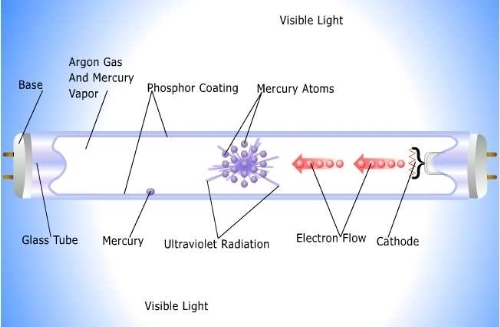
artwork provided by:
ReSoNiC420
What is a
fluorescent light?
A fluorescent light is made
up of a glass tube coated with phosphor, which is filled
with a mixture of gases. When electrical current is
applied, it "excites" the gases, causing the tube to
glow brightly. ie: to "fluores".
Why do
fluorescent lights have different colors?
The
tubing is coated with phosphor, which will determine the
color of the bulb.
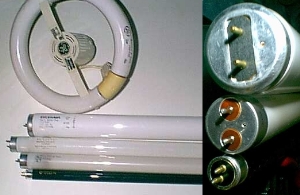 What diameters of fluorescent tubes are
available?These are the most widely used diameter
fluorescent tube size is T-5, T-8 T-10, T-12. Bulb sizes
(meaning diameters) vary from .25 up to 1.5 inch, the
larger in diameter the larger the fluorescent. What diameters of fluorescent tubes are
available?These are the most widely used diameter
fluorescent tube size is T-5, T-8 T-10, T-12. Bulb sizes
(meaning diameters) vary from .25 up to 1.5 inch, the
larger in diameter the larger the fluorescent.
What length is most used?
There is a
wide variety of lengths from 6 to 96 inch, the most
widely used is a 48 inch fixture.
What
wattage is there to use?
Fluorescents come in a
wide range of watts any where from 4 to 214 watts that I
have found.
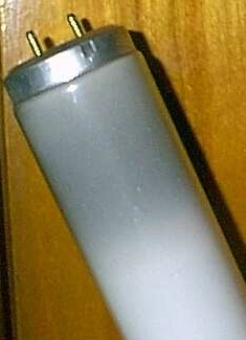
Why does my bulb flicker?
Fluorescent tubes are rated by hours, these hours
vary by the manufacture, the most common rated hours are
from 6000-22000 hrs. The bulb flickering can also be
caused by a poorly seated tube (poor receptacle
contacts), a ballast or starter going bad or a tube
wearing out such as shown in the photograph.
How do I dispose of these lights when they
are broke?
Although commercially generated
fluorescent lights are required by law, to be handled
separately from general trash. Residents are allowed to
dispose of them with the rest of their household
garbage.
Where can I purchase fluorescent
tubes, and how much do they cost?
Fluorescents
can be purchased at all home improvement centers,
hardware stores, and most pet supply stores or you can
go to internet sites such as
http://www.1000bulbs.com/. The cost
may vary depending were you reside, but the typical cost
is a few dollar's for a pack of two bulbs.
Who manufactures these lights?
These are the most reliable companies on the market
today: Sylvania, Westinghouse, General Electric.
What are lumens?
Lumens are the unit
of measure that state the amount of light output
produced by a light source. The higher the lumens, the
greater the light output. The standard fluorescent tube
should produce at least (3000-3300) lumens.
How can I optimize the light output?
You can help reflect the light out of each tube, by
using metal foil tape as a reflector, attached directly
to the tube as shown in this faq. click
here Using clear plastic safety sleeves over the
fluorescent tubes allows you to recycle the metal foil
reflective tape.
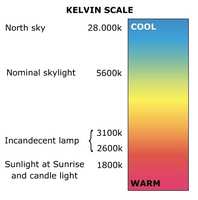
What is a
Kelvin scale?
One way light is measured is on a
Kelvin scale. A Kelvin scale expresses the exact color
the bulb emits. Bulbs in the range of 2700 to 6500 on a
Kelvin scale is ideal for growing marijuana. Plants
respond not only to the quantity of light, but also the
quality.
* artwork provided by:
ReSoNiC420 (click chart to enlarge)
What color spectrums
are available in fluorescent bulbs?
Fluorescent
bulbs have the most range of spectrums than any other
bulb. The spectrum comes in various spectrums,
determined by the type of phosphor with which the bulb
is coated. The following fluorescent types are as
listed, along with what they may accomplish for you.
Full spectrum fluorescent bulbs have all the colors
of the Kelvin scale. This bulb is good for vegetation
stage. Note: This spectrum fluorescent is used in
hospitals nationwide in helping people with
"depression".
Wide spectrum fluorescent bulbs will restrict
development of side branching, helps plants mature
faster. This fluorescent is high in the red, orange and
yellow color range. In fact, this fluorescent is the
highest than all other fluorescent bulbs. As a matter of
fact, this fluorescent is much like an HPS color range,
which makes it the best all around choice for flowering
stage.
Daylight spectrum fluorescent bulbs are very high
(if not the highest) in the blue range on the Kelvin
scale. This fluorescent promotes an arctic blue look. I
suggest this fluorescent during vegetation stage.
Cool spectrum fluorescent bulbs will promote
multiple side growth, nice green foliage. This
fluorescent is high in the blue range, giving off a
bright white appearance. I suggest this fluorescent for
vegetation stage.
Warm spectrum fluorescent, will promote extra thick
stems and branches, and will give you about 5% denser
buds than other spectrums. This fluorescent is high in
the red range on the Kelvin scale.
In the old school of fluorescent growing, an even
mix of warm white and cool white tubes has been proven
to be the best combination of light spectrums to use for
flowering stage. If wide spectrum bulbs are unavailable
in your area, then this is the combo to use.
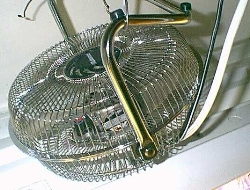
Do fluorescent tubes need air
circulation?
Fluorescent tubes do get warm, but not if they have
adequate air circulation. A simple fan blowing over the
fixtures as shown, will help a great deal to cool the
tubes.
If its done properly, any stray foliage that
comes in contact with the tubes will not be
harmed.
|
| Last modified: 04:55 - Jul 12,
2003 |
| |